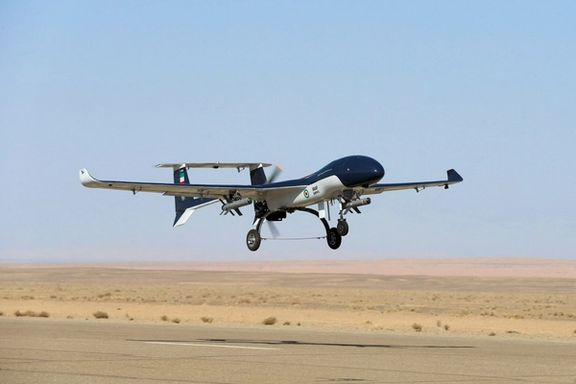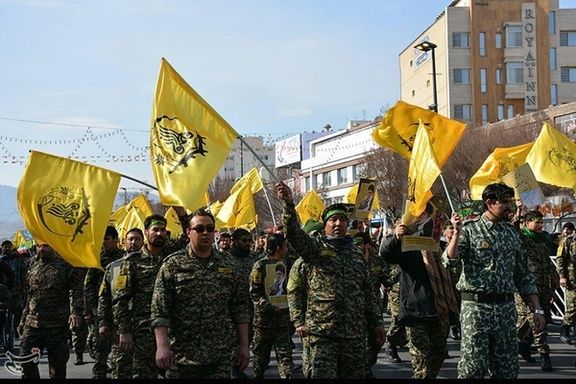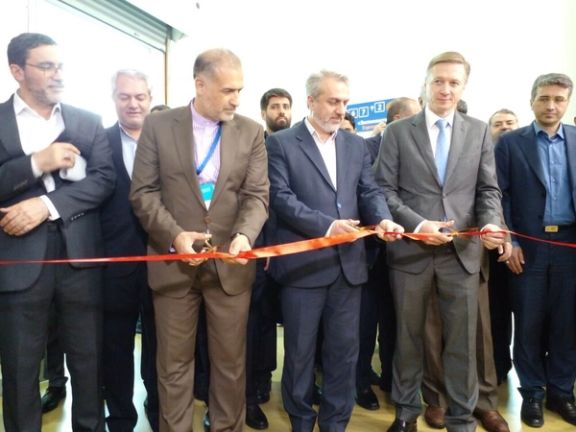Iran’s Army Launches Large-Scale Drone War Games

Iran’s Army has started a large-scale drone drill, featuring its reconnaissance and combat drones in the Persian Gulf and the Sea of Oman, as well as over its territory.

Iran’s Army has started a large-scale drone drill, featuring its reconnaissance and combat drones in the Persian Gulf and the Sea of Oman, as well as over its territory.
Vice Admiral Mahmoud Mousavi, the deputy of Army Operations and Spokesman for the Army's 1401 joint drone exercise said on Wednesday that surveillance drones operated by the four units of the Army, namely the Ground Force, Navy, Air Force and Air Defense Force, successfully carried out their intelligence-gathering and patrol missions on the first day of the two-day drill.
In addition to Mohajer-6 ISTAR (intelligence, surveillance, target acquisition, and reconnaissance) aircraft, various Iranian-made drones such as Yasir, Sadeq, Yazdan and Ababil-3 tactical surveillance unmanned aerial vehicles as well as Pelican vertical takeoff and landing (VTOL) naval drone were flown from different bases across the country, he said, adding that the aircraft successfully identified designated targets in the general zone of the exercise as well as international waters.
The Army has as set up a command-and-control network for the drone operations to expand unmanned aerial capabilities, execute drone missions and coordinate such flights, Mousavi said, boasting that “This exercise exhibits only a small fraction of the achievements made by the Islamic Republic of Iran Army regarding domestically-developed drones.”
Deputy Chief of the Iranian Army for Coordination Rear Admiral Habibollah Sayyari said on Tuesday that more than 150 new advanced drones will be flown in the drill.
Earlier in the month, Iran’s Revolutionary Guard confirmed that it held joint drone exercises with Russia at the Kashan Air Base, adding that Belarus and Armenia are also partaking in the drills.

UN experts and Amnesty International have expressed deep concern over Iran’s persecution of Baha’is and urged an end to pressure on religious and other minorities.
“We are deeply concerned at the increasing arbitrary arrests, and on occasions, enforced disappearances of members of the Baha’i faith and the destruction or confiscation of their properties, in what bears all the signs of a policy of systematic persecution,” the experts said in a statement Monday.
The Shia clergy consider the Baha’i faith as a heretical sect. Supreme Leader Ali Khamenei has on several occasions called the Baha'i faith a cult and in a religious fatwa in 2018 forbade contact, including business dealings, with followers of the faith.
Bahai’s, who number around 300,000 in Iran, cannot hold jobs in the public sector and are sometimes sacked from their jobs in the private sector under pressure from authorities. They are also deprived from higher education.
Followers of the Baha'i faith say the Islamic Republic has taken its systematic campaign to a higher level in the past few months. Earlier this month Security forces laid siege to a village in northern Iran and demolished houses and farms belonging to members of the persecuted faith.
Security forces have also arrested tens of Baha'is including Mahvash Sabet, Afif Naimi, and Fariba Kamalabadi, three former leaders of the community, and shut down businesses.
The intelligence ministry claimed on August 2 that the detained Baha’is were linked to the Baha’i Universal House of Justice in Haifa, Israel, and had collected information in Iran and conveyed it to their headquarters, implying that such information would be shared with Israel. The Universal House of Justice is the nine-member supreme ruling body of the Bahaʼi Faith.
Signatories of the statement including Javaid Rehman, Special Rapporteur on the situation of human rights in Iran, Fernand de Varennes, Special Rapporteur on Minorities Issues, Nazila Ghanea, Special Rapporteur on freedom of religion, as well as several members of the Working Group on Enforced or Involuntary Disappearances added in their statementthat the acts against Baha’is formed part of a “broader policy to target any dissenting belief or religious practice, including Christian converts, Gonabadi dervishes and atheists.”
“The international community cannot remain silent while Iranian authorities use overbroad and vague national security and espionage charges to silence religious minorities or people with dissenting opinions, remove them from their homes and effectively force them into internal displacement,” the experts said.
Amnesty International launched an urgent appeal regarding the escalation of attacks on Baha’is human rights Tuesday, urging national chapters and concerned individuals to write to three Iranian officials including Chief Justice Gholamhossein Mohseni Ejeiand urge them. to “immediately and unconditionally release” all the Baha’is recently detained as well as those in prison from before and “quash all convictions and sentences imposed on this basis.”
Amnesty’s appeal said detainedBaha’is are targeted solely for the peaceful exercise of their right to freedom of religion and called on authorities to end discrimination against the community in law and in practice, including in access to employment, housing, and agricultural, industrial, trade and other activities necessary for the enjoyment of social, economic and cultural rights.
For decades Iran has not allowed visits to any of the fourteen UN human rights experts who have made requests to monitor the situation of human rights.

The US military carried out air strikes on Tuesday in Syria against facilities used by groups affiliated with Iran's Revolutionary Guards Corps (IRGC).
The strikes in Deir al-Zor area came even as the United States aimed to respond to a draft agreement proposed by the European Union that would bring back the 2015 nuclear deal with Iran that former President Donald Trump abandoned, and current President Joe Biden has sought to revive.
The military's Central Command said in a statement that such strikes were aimed at protecting US forces from attack by Iran-backed groups.
Iran has so far not commented on the attack and government-controlled media did not report the development on Wednesday.
It cited one such incident on Aug. 15, which Reuters has reported involved drone attack on a compound run by coalition and US-backed Syrian opposition fighters, with no casualties.
Reports say the US will likely respond to the EU proposal on the nuclear talks on Wednesday, most probably followed by more indirect negotiations with Iran to resolve all differences.
The agreement is strictly about restricting Iran’s nuclear program in exchange for US sanctions relief and does not cover other issues, such as Iran’s aggressive activities in the region or its missile program.
The Biden Administration has refused to lift sanctions imposed in 2019 on the IRGC for its “malign activities” and support for proxy groups in the Middle East as part of the nuclear deal.
"The president gave the direction for these strikes," said spokesman Army Colonel Joe Buccino.
Central Command called the strikes a "proportionate, deliberate action intended to limit the risk of escalation and minimize the risk of casualties."
The statement about Tuesday's US strike did not mention whether there were any casualties and did not say whether the air strikes were carried out by manned or unmanned aircraft.
This is not the first time US warplanes have struck Iran-backed forces in Iraq and Syria. The United States hit operational and weapons storage facilities at two locations in Syria and one in Iraq in June last year.
US forces first deployed into Syria during the Obama's administration's campaign against Islamic State, partnering with a Kurdish-led group called the Syrian Democratic Forces. There are about 900 U.S. troops in Syria, most of them in the east.
But Iran-backed militias established a foothold in Syria while fighting in support of President Bashar al-Assad during Syria's civil war.
Iranian-backed militias are heavily concentrated west of the Euphrates in Deir al-Zor province, where they get supplies from Iraq through the al-Bukamal border crossing.
Israel, which strongly oppose the Iranian presence in Syria, has launched hundreds of airstrikes against Iranian positions and those of its allies in Syria.
An IRGC general was killed in Syria last week, reportedly in the latest airstrike carried out against Iranian bases.
With reporting by Reuters

The Israeli premier has called on Washington to refrain from signing a nuclear agreement with Iran while the country’s defense minister is set to travel to the US to meet senior American officials.
Defense Minister Benny Gantz will depart for an official visit to the US and Japan on Thursday August 25, his office said on Tuesday, adding that in the US, Gantz will hold a series of meetings at CENTCOM headquarters in Florida and meet with National Security Advisor Jake Sullivan in Washington, DC. Israel's National Security Adviser Eyal Hulata is also in Washington.
Also on Tuesday, Naftali Bennett urged President Joe Biden to refrain “even now at this last minute” from reviving the 2015 nuclear deal (JCPOA). “This agreement will send approximately a quarter of a trillion dollars to the Iranian terror administration's pocket and to its regional proxies, and will enable Iran to develop, install and operate centrifuges, with almost no restrictions, in a mere two years,” he tweeted.
Expressing hope to dissuade the US from restoring the nuclear accord with the Islamic Republic, he said, “Throughout the past year, even when it was very close, we successfully convinced our White House counterparts not to give in to Iranian demands.”
Reiterating Israel’s opposition to the deal with Iran, Bennett noted, “Israel is not committed to any of the restrictions stemming from the agreement and will utilize all available tools to prevent the Iranian nuclear program from advancing.”
There have been clear signs in recent days that EU proposals of August 8 are closing lingering Washington-Tehran gaps over reviving the deal.

Around 50 Iranian companies from the automotive sector have showcased their parts and equipment in Russia’s main car show while the country itself is struggling to make good quality vehicles.
Iran’s Industries Minister Reza Fatemi-Amin traveled to Moscow at the head of a large delegation to attend the opening ceremony of the MIMS Automobility Moscow 2022, from August 22 to 25.
He told IRNA that the show marks a turning point in automotive industry cooperation between Iran and Russia as the two countries seek to offset the impacts of foreign sanctions on their economies.
Seeking to expand their markets in Russia, Iran’s largest carmaker the Iran Khodro Company, branded as IKCO, and its rival Saipa plan to cooperate with Russian automakers in car productions, such as a project between Saipa and Russia’s AvtoVaz -- maker of the Lada -- to manufacture a Renault model that was discontinued in Iran in 2018 after the French company left Iran because of US sanctions.
Sixteen European car manufacturers (including four of the top 10 by market share) sold close to half a million units of Russia’s total sales of 1.67 million in 2021, making the country the eight-largest car market in the world in terms of global sales volumes. But following the sanctions over the Russian invasion of Ukraine, almost all foreign firms left and car sales were down by 84 percent in May.
Criticizing Iranian automakers for producing low-quality vehicles responsible for a high rate of road accident casualties, Iran’s traffic police said Tuesday that substandard and unsafe cars lead to at least 17,000 deaths and 300,000 injuries every year.

Fars news agency in Tehran has again brought up the issue of an energy crunch, arguing that Europe needs a nuclear deal with Iran not to "freeze this winter."
Fars, linked to the Revolutionary Guard, is not the only government-controlled media outlet periodically bringing up this issue, as Iran negotiates with the United States through the Europeans to restore the 2015 nuclear deal (JCPOA).
Once the deal is restored the United States will lift oil export sanctions imposed by former President Donald Trump when he withdrew from the JCPOA in 2018. It will also remove international banking restrictions also imposed as part of Trump’s ‘maximum pressure’ on Tehran.
But what Iranian media presents as ‘Europe’s freezing winter” has almost nothing to do with Tehran’s crude oil exports, except generally helping to bring down oil prices. Europe’s need to replace Russian gas is a specific issue on its own that Iran cannot help with at all.
There are two major reasons why a nuclear agreement now cannot impact Iran’s ability to export natural gas for the foreseeable future.
First is Iran’s huge domestic need that exceeds its current production capacity, and second is the absence of the infrastructure to export the gas as LNG.
Iran produces around 750 million cubic meters of gas per day, which is a considerable amount, but it has suffered from domestic shortages for the past three years as demand has risen and gas production has plateaued or decreased.

The huge domestic demand primarily comes from extraordinary low prices – a de facto fuel subsidy offered to the population more as a loft-over of the revolutionary days than any good reason. Some estimates say that Iran has sustained a loss of close to $300 billion in the past decade simply by selling gas cheap to domestic consumers. In the same manner, gasoline and electricity are extremely cheap in Iran. A gallon of gasoline is sold at the pump for around 22 US cents.
Natural gas production could have increased with exports in mind, since Iran has the second largest reserves in the world, but for close to 20 years successive government were unable to invest in boosting extraction. The reason for this was both international sanctions (2010-2015) and current US sanctions imposed since 2018. There are also US sanctions prohibiting American participation in Iran’s energy sector going back to 1996.
All these sanctions were imposed because of Iran’s nuclear program and they banned investments and critical technology that only Western energy giants could have provided for expanding production.
Even Chinese energy companies left Iran’s South Pars gas field in the Persian Gulf that can easily produce more than 10 percent of global needs.
Having fallen behind in gas production, Iran also never built LNG terminals to serve global markets, like its tiny neighbor Qatar has done. Building such terminals can take 3-5 years, even if a nuclear agreement is signed today and US sanctions are lifted. Considering the need to build larger gas platforms to boost production, the time needed for Iran to ship LNG to Europe is at least 7-8 years.
There are also political hurdles Tehran must overcome. Its most important strategic ally is Russia, which would not like Iran taking a big share of its European market. The Iranian government is talking about a “gas swap” with Moscow, which means Russia wants Iran to sell its natural gas.
If current European strategy of replacing Russian gas stays in place in the absence of a resolution to the Ukraine crisis, any gas deal with Iran would mean buying energy from Moscow.